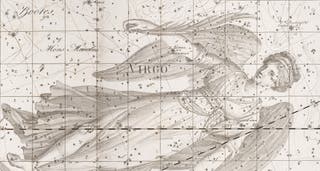Bode, Johann. Vorstellung der Gestirne. Berlin, 1805.
In 1782 Johann Bode published a German version of the 1776 French Flamsteed atlas, using the same order, format, and constellation figures, but with newly engraved plates. This atlas was later reissued, with revisions, in 1805; we exhibit the reissue. The Bode/Flamsteed atlas, as it is best called, is notable for the addition of many more stars; the plates are visibly much richer than the Fortin edition of Flamsteed.
When the first edition of this atlas appeared, in 1782, William Herschel was just beginning to achieve international renown, because of his discovery of Uranus in 1781, using a seven-foot Newtonian telescope. Bode was a great admirer of Herschel’s achievement, and he commemorated the feat by inserting a new constellation, Herschels Teleskop, next to Auriga; it accurately depicts the actual instrument of discovery. By the time of the second edition, Herschel had been honored with two constellations, named after his smaller and his larger reflecting telescopes. Bode depicts the large one in the space between Gemini, Auriga, and Lynx. We compare below the Auriga figures form Bode (left), and Hevelius (right). Note that there are many more stars in the Bode constellation.

